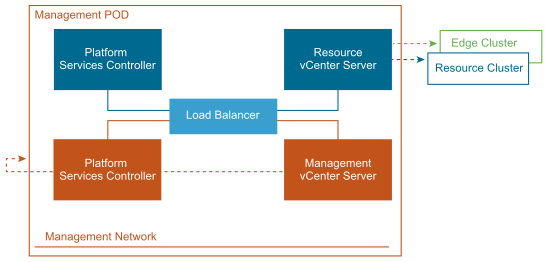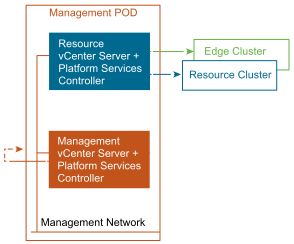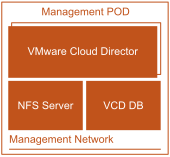The Management Pod contains the components that manage the Telco Cloud Infrastructure runtime environment.
vCenter Server
The Management Pod is implemented as a cluster that is managed by the Management vCenter Server instance. The Management Pod hosts the management domain and all the edge management domains. To form the foundation of a carrier-grade virtualized infrastructure, the components of the Management Pod benefit from the cluster features such as resource management, high availability, and resiliency. A Resource vCenter Server is deployed to manage the Resource Pods and an Edge Resource vCenter Server is deployed to manage Edge sites.
Each vCenter Server instance is a virtual appliance that is deployed with an embedded database. The vCenter® Server Appliance™ is preconfigured, hardened, and fast to deploy. The appliance allows for a simplified design, eases management, and reduces administrative efforts. vCenter Server Appliance availability is ensured by using either vSphere High Availability or vCenter High Availability (vCenter HA) cluster, which is realized through three vCenter Server Appliance instances.
The Platform Services Controller contains common infrastructure security services such as VMware vCenter® Single Sign-On, VMware Certificate Authority, licensing, service registration, and certificate management services. The Platform Services Controller handles identity management for administrators and applications that interact with the vSphere platform. The Platform Services Controller may be deployed as a load-balanced pair of appliances per vCenter Server as shown in the following diagram:

Alternatively, the Platform Services Controller and its related services may be embedded within the vCenter Server Appliance. This eliminates the need for separate Platform Services Controller VM instances and their corresponding load balancers, thus simplifying its deployment and administration and also reducing the management components footprint.

VMware NSX-T Data Center
NSX Manager is a management plane component of the NSX-T system. It provides the ability to create, configure, and monitor NSX-T Data Center components, such as segments, gateways, and NSX Edge Nodes.
NSX Manager provides an aggregated system view and centralized network management of NSX-T Data Center. It provides a method for monitoring and troubleshooting workloads that are attached to the virtual networks that NSX-T Data Center creates. NSX-T Data Center provides configuration and orchestration of logical networking components such as segments and gateways, networking services, Edge services, security services, and distributed firewall capabilities.
NSX Manager contains an advanced distributed state management system that controls virtual networks and overlay transport tunnels. NSX Controller is part of the converged NSX Manager appliance and deployed as a three-node highly available cluster, responsible for the programmatic deployment of virtual networks across the entire NSX-T Data Center architecture. The control plane is split into two parts in NSX-T Data Center:
Central Control Plane (CCP) that runs on the NSX Controller cluster nodes. The CCP computes some ephemeral runtime state based on configuration from the management plane and disseminates information reported through the local control plane by the data plane elements. The CCP is logically separated from all data plane traffic, therefore any failure in the control plane does not affect the existing data plane operations.
Local Control Plane (LCP) that runs on the transport nodes, adjacent to the data plane it controls. The LCP monitors local link status, computes most ephemeral runtime state based on updates from the data plane and CCP, and pushes the stateless configuration to forwarding engines. The LCP shares fate with the data plane element that hosts it.
NSX Managers are deployed as a cluster of three manager nodes for high availability with anti-affinity rules configured to ensure that the NSX Managers and the CCP reside on separate hosts to protect against host failures. The LCP shares fate with the data plane element that hosts it, while the CCP inherits the same fate as the NSX Manager in terms of availability. The NSX Manager communicates with Edge clusters over a common management network. The management components of the Telco Cloud Infrastructure platform communicate over the same management network to request network services from the NSX Manager.
VMware Cloud Director
VMware Cloud Director is an abstraction layer that operates on top of other VIM components, vCenter Server, and NSX Manager. A highly available VMware Cloud Director implementation that uses multiple load-balanced VMware Cloud Director cells is deployed in a VMware Cloud Director Server Group. All cells in the server group are stateless and use a shared highly available clustered database. Each cell contains all the software components required for VMware Cloud Director. A cell can run on its own, but multiple cells running in an active-active cluster are used for scalability and redundancy.

VMware Cloud Director builds a secure, multitenant virtual environment by pooling virtual infrastructure resources to Virtual Data Centers (VDCs) and exposing them to users through Web-based portals and APIs as fully automated, catalog-based services.
A fundamental concept in VMware Cloud Director is that of the tenant. A tenant is a logically isolated construct representing a customer, department, network function, or service, used to carve out infrastructure resources and deploy VNF workloads. VMware Cloud Director isolates administrative boundaries to tenants. VNF workload resource consumption is therefore segmented from other VNF workloads, even though the VNFs can share the resources.
VMware Cloud Director implements the open and publicly available VMware Cloud Director API, which provides compatibility, interoperability, and programmatic extensibility to Network Equipment Providers (NEPs) and their VNF Managers. The VMware Cloud Director capabilities can be extended to create adapters to external systems including OSS/BSS.